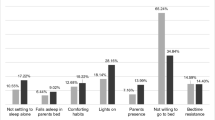Abstract
Background: There are cross-cultural variations in sleep habits among children. No previous study has assessed the prevalence of cosleeping in school-aged children in Middle Eastern countries.Purpose: To assess the prevalence of, and the factors associated with, cosleeping in Saudi school-aged children.Methods: Questionnaires were distributed according to a specified sampling procedure, and parents were asked to rate each item that described their child’s behavior within the previous 6 months. Cosleeping was defined as all-night sharing of a bed or room with a parent. Results: Data were analyzed for 977 children (50.5% boys) with a mean age of 9.5 ± 1.9 years and a range from 5 to 12 years. Cosleeping with parents was reported by 26% (95% CI: 23.2–28.7%) of the sample. According to a multivariate logistic regression model, a child’s school level, enuresis, and nightmares were the only predictors of cosleeping.Conclusion: This study demonstrated that cosleeping is more common among Saudi school-aged children than has been reported for other countries. When assessing children’s sleep, the practitioner should give special consideration to the child’s needs, and his/her family’s cultural background.
Similar content being viewed by others
References
APA (American Psychiatric Association). (1994).Diagnostic and statistical manual of mental disorders, 4th ed. (DSM-VI). Washington, DC: The American Psychiatric Association.
Andres, T., Carskadon, M. A., Dement, W. C., & Harvey. K. (1978). Sleep habits of children and the identification of pathologically sleepy children.Child Psychiatry and Human Development, 9, 56–63.
BaHammam, A., AlFaris, E., Shaikh, S., & Bin Saeed, A. (2006). Prevalence of sleep problems and habits in a sample of Saudi primary school children.Annals of Saudi Medicine, 26, 7–13.
Cortesi, F., Giannotti, F., Sebastiani, T., & Vagnoni, C. (2004). Cosleeping and sleep behavior in Italian school-aged children.Journal of Developmental and Behavioral Pediatrics, 25(1), 28–33.
Epstein, R., Chillag, N., & La vie. P. (1998). Starting times of school: Effects on daytime functioning of fifth-grade children in Israel.Sleep, 21, 250–256.
Jenni, O., Fuhrer, H. Z., Iglowstein, I., Molinari, L., & Largo, R. H. (2005). A longitudinal study of bed sharing and sleep problems among Swiss children in the first 10 years of life.Pediatrics, 115(1 Suppl), 233–240.
Jenni, O. G., & O’Connor, B. B. (2005). Children’s sleep: An interplay between culture and biology.Pediatrics, 115(1 Suppl), 204–216.
Latz, S., Wolf, A. W., & Lozoff, B. (1999). Cosleeping in context: Sleep practices and problems in young children in Japan and the United States.Archives of Pediatric & Adolescent Medicine, 153(4), 339–346.
Okami, P., Weisner, T., & Olmstead, R. (2002). Outcome correlates of parent-child bedsharing: An eighteen-year longitudinal study.Journal of Developmental & Behavioral Pediatrics, 23, 244- 253.
Owens, J., Maxim, R., McGuinn, M., Nobile, C., Msall, M., & Alario, A. (1999). Television-viewing habits and sleep disturbance in school children.Pediatrics, 104(3), e27.
Owens, J. A. (2002). Cosleeping.Journal of Developmental & Behavioral Pediatrics, 23, 254–255.
Ramos, K. D., & Youngclarke, D. M. (2006). Parenting advice books about child sleep: Cosleeping and crying it out.Sleep, 29(12), 1616–1623.
Sadeh, A. (1994). Assessment of intervention for infant night waking: Parental reports and activity-based home monitoring.Journal of Consulting and Clinical Psychology, 62(1), 63–68.
Sheldon, S. (2005). Disorders of initiating and maintaining sleep. In S. Sheldon, R. Ferber, and M. Kryger (Eds.),Principles and practice of pediatric sleep medicine (pp. 137–160). Philadelphia, Elsevier/Saunders.
Tatweer. (1999). The Official Publication of Arriyadh Development Authority (ADA),26, 14 (Arabic version).
Wolfson, A. R., Carskadon, M. A., Acebo, C., Seifer, R., Fallone, G., Labyak, S. E., et al. (2003). Evidence for the validity of a sleep habits survey for adolescents.Sleep, 26(2), 213–216.
Yang, C., & Hahn, H. M. (2002). Cosleeping in young Korean children.Journal of Developmental and Behavioral Pediatrics, 23, 151–157.
Author information
Authors and Affiliations
Corresponding author
Rights and permissions
About this article
Cite this article
BaHammam, A., Alameri, H. & Hersi, A. Cosleeping and its correlates in Saudi school-aged children. Int. J. Behav. Med. 15, 336–340 (2008). https://doi.org/10.1080/10705500802365623
Issue Date:
DOI: https://doi.org/10.1080/10705500802365623




